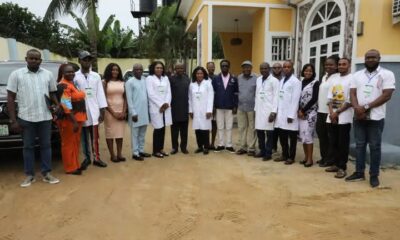Agriculture
Agencies Earmark N211.5bn For Exportable Crops In Two Years
A report on National survey
of exportable agricultural commodities said a total of N211.5billion was committed to exportable crop farming activities during the 2011/2012 survey year.
The report issued in Abuja last Monday by National Bureau of Statistics (NBS), was prepared by Consultative Committee on Agricultural Export Commodities in collaboration with NBS.
It said that the other collaborative agencies were the Central Bank of Nigeria and Federal Ministry of Agriculture and Rural Development.
The report said: “a total of N211.5billion was committed to exportable crop farming activities during the survey period.
The report said that of the figure ‘own fund led the list with N134.19 billion (63.44 per cent), followed by ‘micro credit institutions’ with N36.86 billion (17.42 per cent).
The N134.19 own fund is referred to as personal fund committed to any of the 14 exportable crop farming activities by a holder.
“Community Banks’ recorded the lowest amount of N1.30 billion (0.61 per cent),’’ according to the report.
It stated that disaggregating the own fund into states, Kaduna State recorded the highest with N9.51 billion (7.09 per cent) followed by Kano state with N9.45 billion (7.04 per cent).
Ekiti has the lowest amount of N0.61billion (0.45 per cent).
The report said that the Cooperative Banks contributed N12.62billion (6.00 per cent), Bank of Agriculture N2.10 billion (0.96 per cent), Commercial Banks N1.41 billion (0.67 per cent).
The Community Bank contributed the lowest amount of N1.30billion (0.61 per cent).
It said that the ages between 30 and 49 years committed the highest fund to exportable crop with a percentage of 47.99.
This was followed by holders of ages 50 to 64 years with 30.99 per cent while the age group of 15 to 29 had the lowest percentage of 5.20.
Overall, 984,235 holders reported the use of improved seedling. Kano State reported the highest number of 168,138 (18.17 per cent), followed by Katsina State with 123,006 (12.62 per cent).
Niger State, according to the report, did not report the use of improved seed/seedling.
It stated that Lagos and Bayelsa states reported the least number of holders that used improved seed/seedling with 41 (0.01 per cent) and 250 (0.03 per cent) respectively.
“A total of 27 states and Federal Capital Territory planted cashew on a total land area of 120.17 (‘000) hectares.
“Kwara planted the largest hectares of land of 31.49 (‘000) hectares (26.20 per cent), followed by Imo with 11.86 (‘000) hectares (9.87 per cent)
“The least areas planted were recorded in Rivers and Akwa Ibom states with 0.01 (.000) hectares and 0.55 (.000) hectares respectively,’’ the report said.
Cocoa was cultivated in 18 states on a total land area of 1,363.60 (‘000) hectares, while Cross River cultivated the highest hectares with 327.91 hectares (24.05 per cent), followed by Ondo state with 321.97 hectares (23.61 per cent)
The least cultivated land areas were 0.04 hectares, representing 0.003 per cent by Imo and 0.18 hectares (0.01 per cent) by Rivers State,’’ the report said.
Agriculture
FG, Ogun Distribute Inputs To 2,400 Farmers
Federal Government and the Ogun State Government, on Wednesday, distributed farm inputs to farmers as part of effort to address food security challenge.
The State Director, Federal Ministry of Agriculture and Food Security, Dr. Toyin Ayo-Ajayi, during the flag-off ceremony of Inputs Redemption Under The National Agricultural Growth Scheme-Agro Pocket (NAGS-AP), in Ogun State, disclosed that beneficiaries of the gesture were primarily rice, maize and cassava farmers across the State.
Ayo-Ajayi commended the Ogun State Government for partnering with the government at the centre for the effort in supporting farmers with inputs that would bring about yieldings for local consumption and likely exportation.
She noted that government is supporting rice, cassava and maize farmers with inputs worth N212,000; N189,000 and N186,000 respectively.
The Permanent Secretary in the State Ministry of Agriculture, Mrs Kehinde Jokotoye, who represented the Commissioner in the Ministry, Bolu Owotomo, stated that traditional farmers are critical in food production, hence the need to encourage and support them with inputs that would bring about desired results during harvesting.
Owotomo said: “Let us make good use of this opportunity, so that the success of this phase will make farmers benefit more from the state and federal governments of Nigeria.”
Earlier, State Coordinator, Federal Ministry of Agriculture and Food Security, Dr. Oluwatoyin Ayo-Ajayi, appreciated the present administration for partnering with the federal government for the initiative, adding that the programme is designed to support farmers at the grassroots level in cassava, rice and maize with inputs such as, seeds, pesticides, herbicides and fertilizers, to boost their production and enhance their livelihood.
Agriculture
Niger Allocates 10,000 Hectares For Smallholder Farmers
The Niger State Government has mapped out 10,000 hectares of farmland in Gbapo Community of Katcha Local Government Area of the State for smallholder farmers to benefit from the state government’s agricultural intervention programme.
Two thousand out of the 10,000 holders of the farmlands have already received inputs.
At a flag-off ceremony in Yinti Village, the facilitator of the programme, Shinkafan Nupe, Malam Idris Usman Makanta, assured the farmers of increased distributions to the mapped-out ten thousand (10,000) farmlands if farmers respond positively.
He explained that the commencement of the two thousand is to measure the positive response of farmers before obtaining full-scale support.
Malam Makanta stated that this initiative aligns with the farmers’ initial commitment through Niger Foods, whose mission is primarily geared towards establishing efficient and profitable agricultural businesses to support the present administration of Governor Mohammed Umaru Bago’s quest to boost agricultural productivity in the state.
He also commended Niger Foods for their steadfastness and resilience in the effective implementation of the input financing scheme.
Makanta reiterated the commitment of the State Governor in making judicious use of the arable land in the state.
Shinkafan Nupe, therefore, urged the farmers to support the Governor by using the inputs wisely so that the dream can be actualised.
Agriculture
GO-CARES: Gombe Empowers 573,429 Farmers, Entrepreneurs
The Gombe State Government has empowered a total of 573,429 farmers and entrepreneurs under the 4th phase of the GO-CARES programme.
The programme was officially flagged off by Governor Inuwa Yahaya in another major step towards alleviating poverty and supporting the state’s vulnerable populations.
The Governor, while inaugurating the disbursement in Akko Community of Akko Local Government Area, restated his administration’s commitment to the welfare of vulnerable citizens in the state.
He was represented by the Commissioner for Budget and Economic Planning, Salihu Baba Alkali, who is also the Chairman of the Steering Committee on GO- CARES implementation.
“The 4th phase of GO-CARES will directly and indirectly impact a total of 573,429 citizens across the state. Of these, 152,429 individuals will benefit directly through cash transfers, livelihood grants, agricultural inputs, and operational grants to small businesses”, he stated.
The Governor added that, “421,000 people will be indirect beneficiaries through infrastructural projects such as classroom blocks, healthcare facilities, WASH services, and rural infrastructure projects like culverts and drainages”.
Yahaya, reaffirmed his commitment to ensuring that the state’s most vulnerable citizens are not left behind in the state’s development.
According to him, “Earlier this year, on June 25, 2024, we flagged off the distribution of improved seedlings, fertilizers, and herbicides to less privileged farmers in Malam Sidi, Kwami Local Government Area, signaling the commencement of the 4th phase implementation of GO-CARES under Result Area 2”.
The Governor reiterated that these initiatives have had a significant impact on the livelihoods of beneficiaries and the overall agricultural sector.
He explained that, “Today’s ceremony marked the simultaneous launch of activities under all three GO-CARES Result Areas for the 4th phase. These areas include: State Cash Transfer Grants: 2,500 direct beneficiaries; Labour Intensive Public Works: 2,700 direct beneficiaries; Livelihood Grants: 10,000 direct beneficiaries; and Basic Services: 405,000 indirect beneficiaries”.
-
Opinion4 days ago
Checking Herdsmen Rampage
-

 News4 days ago
News4 days agoI’m Committed To Community Dev – Ajinwo
-
Sports4 days ago
Coach Eager To Transform El Kanemi Warriors
-
News4 days ago
Tinubu, Govs Forum Congratulate Okpebholo On S’Court Victory …As Obaseki Expresses Disappointment
-
Rivers4 days ago
NDDC: Staff Walk Ten Kilometers To Commemorate 25th Anniversary
-

 News4 days ago
News4 days agoSenate Replaces Natasha As Committee Chairman
-
Politics4 days ago
Obey Order On AA In Six Days, Court Directs INEC, Yakubu
-

 Niger Delta4 days ago
Niger Delta4 days agoHYPREP Trains Lab Technicians To Standardise Water Quality In Ogoniland

